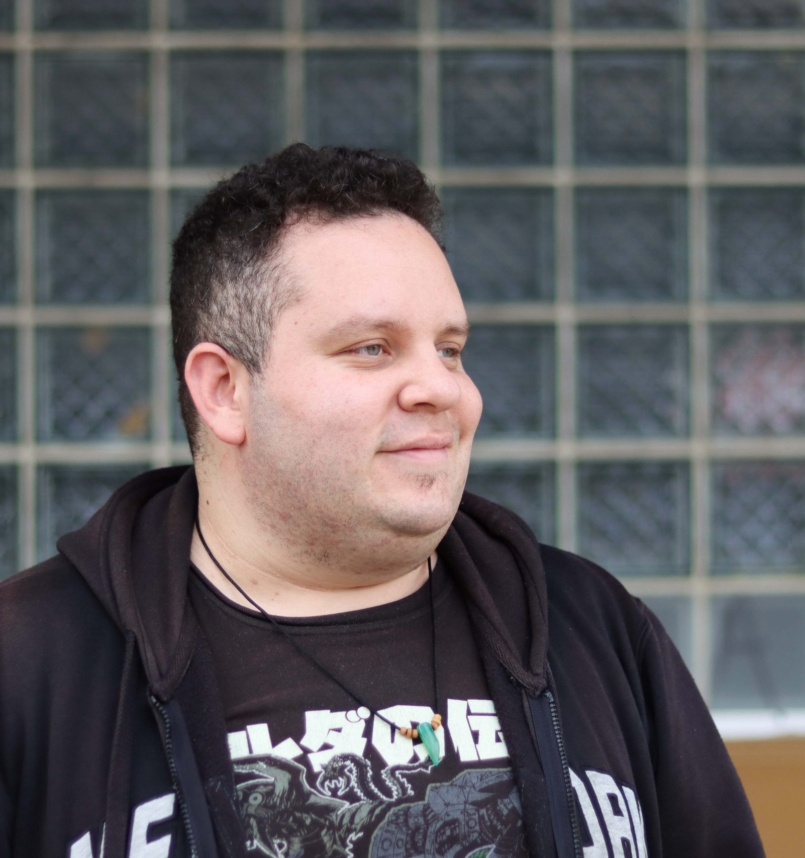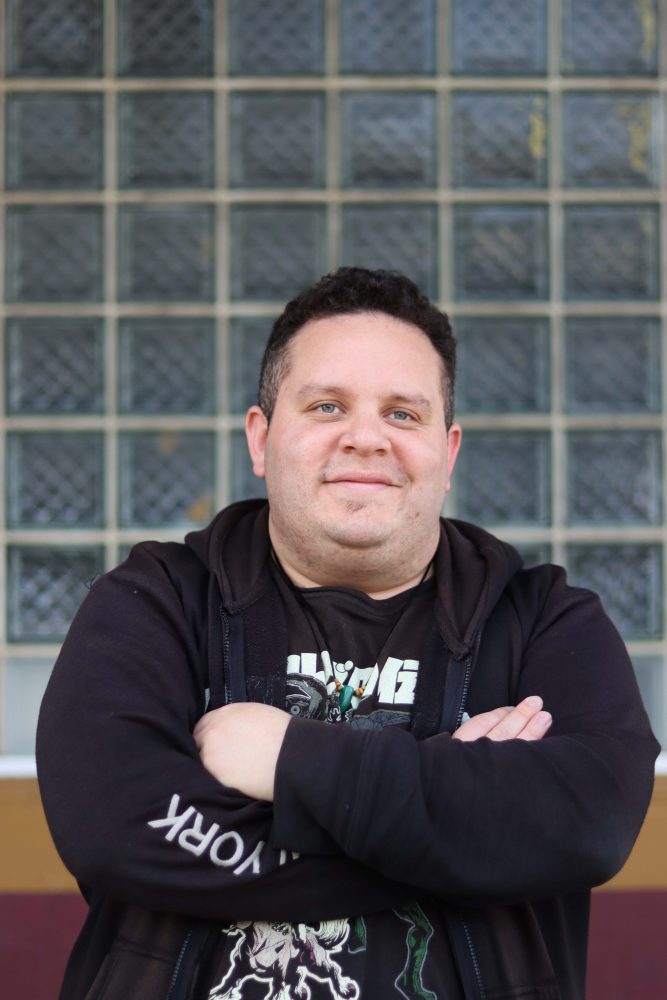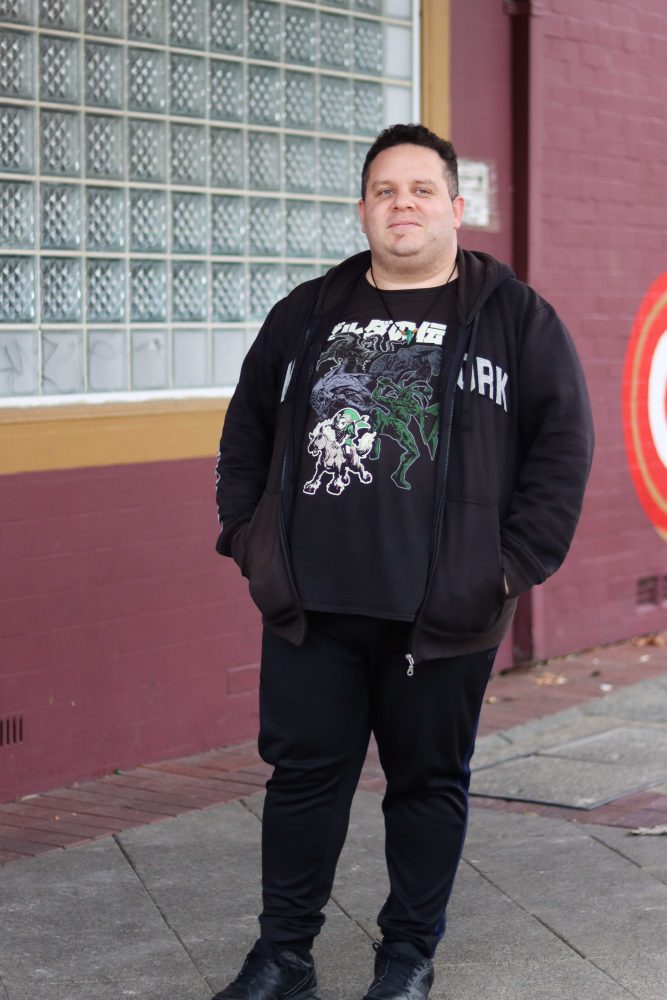Heartlines
Raf Gonzalez

Heartlines explores what it means to write – from the heart and soul – and where that writing takes us. Every writers’ journey is different, so we invite you to take a moment to read, pause and reflect on what it means to shape stories for the page.
Rafael Gonzalez is a writer and poet who provides support at DADAA for their writing workshops and receives mentorships. He has been published within the Los Angeles Review of Books, Journal, To Hold the Clouds anthology, DADAA and Different Lens. Anika Donnison sat down with Rafael to talk about what inspires his writing, how The Simpsons lead him to research Edgar Allen Poe, and his expertise in using MS Paint.
Anika Donnison: My first question is what are you currently reading and why?
Rafael Gonzalez: Oh, I am currently trying to read up on Edgar Allen Poe’s works because I do recite his famous poem The Raven a lot. I am just starting on The Gold Bug. Although it’s interesting with the speech patterns he created for some characters in here – you don’t really hear people write like that anymore, or, you don’t hear people talk like that, because that’s how they spoke back then. But nowadays we’re a bit more, I think, professional. Its just that I’m trying to understand the type of tones he uses or the type of ways he phrases certain words. I mean he’s from the 19th century so it’s a lot for me to grapple with – the fact that’s not the way we talk or the way we write these days. It’s just to get the idea of the mood. But also, since learning about poetry, I only knew one famous poem and that was The Raven through the first The Simpsons treehouse of horror episode. It was the fact that it was a retelling of The Raven. Of course, some kids weren’t scared but still it created the right atmosphere for it. I think it was understanding those types of writings, to learn from all different writers to develop my own writing.
AD: I think I’ve read Edgar Allen Poe’s The Tell-Tale Heart. Compared to a modern horror short story I felt that Poe’s induced more horror within me.
RG: Yeah, I think people look at Poe’s work as a way to look into the mind. Because he delved into a few types of emotions. Like The Raven tackled grief and madness, and how the narrator was dealing with madness because there was one raven that kept bugging him. I mean I will use The Simpsons episode to highlight – for Homer, the way he portrayed it was that he was annoyed with the raven. It went off script because, I mean it’s The Simpsons, it was the idea that he was getting barking mad because the raven was pestering him. But I think that was the way that story went. I’m one of those people who can’t really stand the kind of horror movies that are, like, plagues or zombies. I’m old school. I prefer the Michael Jackson Thriller style. But people forget that style because they always want to use the Romero zombies because they’re classic. Yeah, they’re classic, because they’re classically overdone. I love the classics. Overall, I am trying to figure out some writing skills.
AD: Why do you write?
RG: I reference this a lot, but my mum pointed this out to me years ago – the one thing she said to me was, “Put something out there that is you. That is original.” So, I started writing. I mean I do write my own stuff. I even keep it up by doing fanfiction, which helps a little bit. Although fanfiction – I keep to a certain area, so that I know that’s kept at a good pace. But if I want to do my own thing or need help with my writing, I try to do something that is original to people. Whatever is obsessively on my mind, I write about it. I submitted a poem to the Centre for Stories about the dead mall phenomenon in the United States. They have a lot of malls that are dying out. Someone gave me the idea of, “why don’t you do this from the perspective of the building?” and I couldn’t get that out of my head. I did it about Garden City, and how this building is having an identity crisis and playing itself up for the customers. Anything that becomes obsessive I need to write down.
Along the way, while taking breaks from writing essays, I found out that I was good at spoken word poetry: I learnt that you keep the forms and patterns, you don’t have to rhyme. I made it like a fun activity, like find something interesting. I even did one on troll dolls [chuckles]. I think, since I was young, I always knew I was a creative person. I break the trend of autistic people who are good at maths or science because I was very bad at maths. The only time I ever passed science was in physics or astronomy. I ended up becoming a big history buff. Anything I would become obsessed with. I just write to get my creativity out there. It helps me out.

AD: What do you do outside of writing?
RG: Considering what I went through during lockdown, I have been jobless for sixteen months. Currently, I have been receiving mentorships at DADAA since 2017, and it has been really good. It’s a place where I can hone my creativity. Because, before then, I had actually written a manuscript and I needed help with some editing. At the time, I was just going to get this manuscript ready for publishing. I also worked on some of my other writings, like essays and critiques. I also do a lot of art. I draw and do pixel art. I have a diploma in graphic design. It keeps me sane. The art is a way for me to find my own thing. It helps me find my escape. I’m learning to be an arts worker at DADAA. It’s a slow process but we just started a writing workshop. I guess you could say I am a jack of all trades. In the past, I worked as a kitchen hand and at a printing company.
AD: What was the first book you remember loving?
RD: Excluding the Harry Potter books. I’ll have to use a comic book. The first one I was ever given was Shadowman #0. It was a special edition comic. It had a metallic foil cover and was an independent comic, outside of Marvel or DC. It was their own type of book. It really got me interested in the concept of necromancy and therefore leading into my interest of creating my own stuff. In terms of novels, I’ve read movie novels – a movie turned book – it adds something that nobody expected. Back in high school, I remember seeing these adaptations of movies. My favourite movie of all time is The Fifth Element. There was a novel version of this movie, I borrowed it out a few times. They added bits that they didn’t have in the movie and changed things up. But I knew what it related to. It plays out differently. There were extra bits that should have been in the movie. It’s interesting to see what a writer does with a movie and makes it into a scripted piece.
AD: What is a book that changed your life?
RG: In terms of both novels and comic books, I have very eclectic taste and like to dabble in all different mediums. I talked about Shadowman #0, in terms of writing things out. It was after reading this comic book that I realised “oh, there are different layers to this concept” and so I can imagine with autism that there are different layers. Learning along the way about my autism I also learnt a lot more insights. This manuscript I’ve been writing has helped me to become more aware of myself. Such as comparing magic, which has been demonised throughout history, to autism, which is very misunderstood, within an analogy.
AD: What is your most surprising hobby?
RG
I like keeping up with visuals. I will have something interesting in my head and just want to get it down. I do pixel art. As an old school computer user, as most of us have windows 10 or Macs, I prefer to use Paint – the simple painting software. I have been using this since I started working on a computer. We have this fan group on an online forum community that do ‘microheroes,’ comic book fans, like myself, that want to recreate the comic book characters or create their own characters from scratch. It helps to be able to reuse some of the templates we use, such as capes. If I need an escape from reality, I like to do something visually. I like to see how things look. I am a part of this forum, they really encourage original stuff, they give me really good feedback. My current favourite is the X-Men.
AD: How does the hot desk fellowship influence or challenge your writing, specifically that you wanted a routine?
RG: I mean it helped in my routine; I was having to get up early on Wednesdays to go in. I think I developed a habit of drinking a lot of coffee. The routine was good. Now, I’m out of the routine. It was really good, a good place where I had that structure. The thing I struggled with was that I was there to write, but sometimes I just had nothing. I was embarrassed to say it. So, I decided I needed to find a way, and that’s where the poetry came along. So, in between my essays, I was writing poetry and was given the advice to take breaks instead of getting bogged down. Beyond the routine, I was able to really draw experiences from everyday nuisances, such as spam calls or being broke, and make poems talking about them. Those poems came from the struggles, from being jobless et cetera.
AD: What is the best writing advice you could give or that you have received?
RG: I think it’s just what my mum told me: to put something out there that is original, or different. So, for writers, we could tell our own stories very easily – or reluctantly – but at the same time, one of these days we may not want to tell our own stories. What if we want to make a story that is different? Sure, we have to take bits from what we like or our interests. No matter where we are hearkening from, we are making our own thing. We want to try something different.
AD: What will you be working on next?
RG: I’m currently co-running a writing workshop for DADAA, it is the first writing workshop to be run by DADAA. It’s a space for artists with lived experiences to have to chance to write freely, with prompts to get them started. At the moment we are giving the writers lessons to learn different writing styles so that they might find their own niche. Currently, I am still receiving the writing mentorship at DADAA and my further development as an emerging arts worker. Creatively, I am still making stuff as I go.

Rafael (Raf) Gonzalez is a Latino multi-disciplinary artist; born and raised in Perth, he comes from a family of migrants who moved from El Salvador to Western Australia during the Salvadoran Civil War. Raf is a proud Aspie whose work highlights often marginalised diverse identities, raising them from supporting character to the protagonist, and giving them the agency they often aren’t afforded. Raf has been supported by DADAA and Centre for Stories with his writing. In 2020, Raf has had two of his personal essays published online: ‘How the Arts Can Save Us’ and ‘Language Barrier’. His most recent achievements include seeing his essay ‘My Self Awareness: The boy from Chinameca’ published as part of the To Hold the Clouds anthology series and being a Writer/Director attachment involved in the Different Lens documentary series collaboration between Carers WA, Screenwest and Rhythm Content seen on YouTube.
Anika Donnison studied Professional Writing and Publishing at Curtin University. She has appeared in GROK and COZE. She currently works as a Social Media Coordinator for Pegasus Professional Accounting.
Writing Change, Writing Inclusion is Centre for Stories’ signature writing program for 2021 to 2023. Generously funded by The Ian Potter Foundation, Australia Council for the Arts and Centre for Stories Founders Circle, this writing program features mentoring, hot desk, and publication opportunities for emerging writers from culturally and linguistically diverse backgrounds and/or Aboriginal and/or Torres Strait Islander backgrounds.